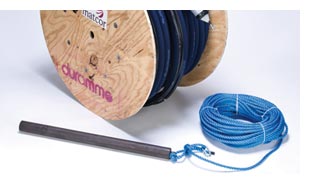Cathodic Protection Systems

Cathodic protection systems protect infrastructure assets such as above ground storage tanks, buried pipelines, reinforcing steel in concrete structures, heat exchangers, marine piles, sheet pile walls or other metallic structures from corrosion.
Cathodic protection (CP) is the process of using DC currents to prevent or reduce the corrosion of metal surfaces by transferring the corrosion from the protected structure to another known location, where the current-discharging anode(s) can be designed for maximum life and ease of replacement.
Corrosion is a leading cause of premature failure in metallic structures. Operators can extend the service life of their facilities and equipment by installing cathodic protection systems (CP systems) and testing them regularly.
A wide range of civil and industrial applications have used cathodic protection systems to prevent corrosion for many years. Cathodic protection systems are typically installed during original construction, major expansions or upgrades. MATCOR cathodic protection systems are typically designed to operate for 30 years or longer.
Types of Cathodic Protection Systems
Cathodic protection is a means of preventing metal structures—such as pipelines and storage tanks—from reacting with the environment and corroding. When exposed to the environment, carbon steel and other metals break down electrochemically and ultimately fail. Cathodic protection systems prevent the oxidation process from occurring by creating a current flow from the cathodic protection system to the structure.
There are two basic types of CP systems: galvanic and impressed current.
Galvanic Cathodic Protection Systems
Galvanic corrosion is an electrical-chemical process where one metal is more susceptible to corrosion than another when both metals are linked electrically. Galvanic (also called sacrificial) anodes utilized in cathodic protection of steel structures are an example of galvanic corrosion, where the galvanic anode corrodes to protect the structure.
A sacrificial anode is a metal anode electrically linked to the structure to be protected that is more reactive to the surrounding corrosive environment. The sacrificial anode corrodes, protecting the metal of the structure being protected.
In a galvanic cathodic protection system, the anodes connected to the protected structure have a natural potential that is more negative than the structure’s. When connected current flows from the anode (more negative potential) to the structure (less negative potential) in a DC circuit.
Galvanic anodes (also referred to as sacrificial anodes), when properly applied, can be used to protect underground steel, marine, internal and industrial structures from corrosion. They do not require an outside power source to operate and are therefore limited in their use. Where properly applied they can be designed to provide long life with ease of operation. Galvanic/sacrificial anodes are available in a variety of configurations, including:
Impressed Current Cathodic Protection Systems
In many applications, the potential difference between the galvanic/sacrificial anode and the steel structure is not enough to generate sufficient current for cathodic protection to occur. In these cases, a power supply (rectifier) is used to generate larger potential differences, enabling more current to flow to the structure being protected. This is referred to as an impressed current cathodic protection system.
Cathodic Protection Design
To be the most effective and economical, cathodic protection systems must be designed properly. Cathodic protection design is the scientific discipline involving:
Design engineers possessing expertise in cathodic protection and knowledge of the structure to be protected from corrosion should perform all phases of cathodic protection design.
